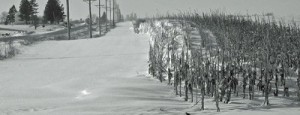A Corny Solution to Snow Drift
- Share
- Tweet
- Pin
- Share

Photo courtesy of Wisconsin Department of Transportation.
The severe winter of 2013-14 will go down as a test of resources for many governmental bodies.
As reported in the Feb. 14 Pulse, the early and unrelenting winter conditions prevented county highway crews from erecting all the snow fences they could have put up, which caused more drifting on some roads.
A report by the Strategic Highway Research Program, a project of the Transportation Research Board, concluded: “National research has found that it costs 100 times more to plow snow than to trap it with a snow fence.”
Erecting the wood-slat snow fences is a time-consuming task for county crews, and when crews are unable to get them in, it makes more work for the road-clearing crews.
As reported in the Feb. 14 Pulse, the county Highway Committee discussed the idea of unharvested rows of corn to serve as natural fencing. Since 2011 the Wisconsin Department of Transportation has had a program in place that pays farmers 50 cents more a bushel than market price to leave rows of corn unharvested for the winter.
At its March meeting, the Highway Committee decided to seek a willing farmer to take part in a trial next winter.
“Basically, there was support from the committee to develop a program,” said Door County Highway Commissioner John Kolodziej. “What we determined is that, as we go through the summer and farmers are planting corn, we would identify where a good location may be to do a trial program. Not so much recruit in advance, but find out where farmers have planted corn that would be a good test area, the rows are going in the right direction and we can leave some rows far enough back from the edge of the road to make it a feasible site.”
“The corn row snow fence works really well. The money we pay for one plot of standing corn is typically less than the cost of sending out a truck on drift patrol for one storm,” said Michael Sproul of the Wisconsin Department of Transportation’s Bureau of Highway Maintenance. “The problem is getting farmers to participate. This past year several farmers dropped out because they said it was too much trouble getting the combine out in the spring for just a few rows. I see their point.”
Iowa has really taken the lead on researching the use of living snow fences and has conducted multi-year studies using rows of corn as snow fences. They found corn rows to be very effective in helping snow to drift on a field rather than a nearby roadway, and Sproul said Iowa has even taken a different approach to entice farmers to the program.
“They pay the farmer 50 cents more (per bushel) like we do but they work with local clubs like the Girl Scouts and pair them up with the farmers,” Sproul said. “Then the farmer gets paid for the original corn snow fence. The Girl Scouts handpick the corn. The farmer sells the handpicked corn to the mill, writes a check to the Girl Scouts for the amount of the corn. Then the farmer takes a tax write-off for the donation. Everybody wins.”
The department lists these benefits of standing corn row fences to the public and landowner:
Public
• Reduces blowing and drifting snow on roadways
• Stores snow at low cost
• Reduces the accident rate during snowy, windy conditions
• Creates safer travel conditions
• Decreases freezing and thawing effects on the roadway
• Lowers snow removal cost
• Increases visibility
Landowners
• Improves winter access to farmsteads and rural areas
• Helps reduce soil erosion
• Provides a service to your community
• Conserves wildlife
• Can increase yield by retaining moisture and reducing drying effects of the wind
